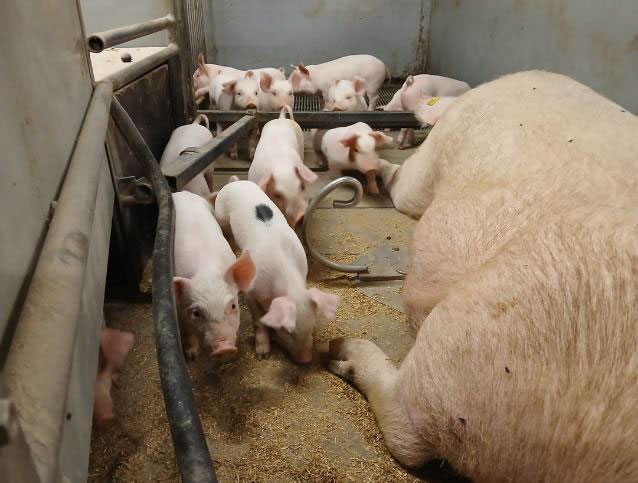Top 5 best practices for banning cages
The experts in this thematic group selected these five best practices from the initial list of 27 candidates.
Following this round, where the Top 5 Best Practices have been selected, the process will continue with the final selection of the 3 Winning Practices.
Card board pigs
It is difficult to decide on the space and dimensions of pens, and to compare the advantages and disadvantages of different pen layouts before investing in and establishing pens for loose lactating sows. Once the decision has been made and the pens have been established, it is irreversible.
This kit consists of a set of cardboard pigs in a 1:20 scale and a checklist to evaluate the functionality of different pen designs. This enables farmers to compare pen designs and discuss them with their advisors, employees, and pen equipment producers before making the significant investment.


Easy access to piglets
This farm constructed their first pens for loose housing of farrowing and lactating sows (zero confinement) in 2003. They wanted a housing system without confinement, meaning sows are never confined and there are no crates/stalls in the farrowing unit, mating unit, or gestation unit.
The key criteria in their design were to place the covered creep (piglet) area so piglets could be reached from the passageway without entering the pen. The reasoning being that their stock people need to check up on piglets in every pen every single day of the year, so it should be easy, fast, and safe to do so – and without interfering with the sow.
At the time they had 550 sows. In 2009, the herd size increased to 1200 sows. Because they had very good experiences with the pen design, the additional pens were made exactly like the initial ones.


MamaGuide
This farmer has kept sows loose during farrowing and lactation (zero confinement) since 2007, during which time he has experienced piglet crushing. In 2023 he created MamaGuide: pen equipment mounted on the floor that prevents loose sows from rolling, thereby reducing the risk of crushing piglets. The challenge it addresses is the increased risk of piglet crushing when sows are loose. MamaGuide can be installed in many existing pens for loose lactating sows, as well as in new pens, regardless of the pen equipment manufacturer.
MamaGuide has been tested in a pilot study. The results showed that it prevented the sows from rolling and had no negative impact on the piglets.

Temporary confinement
This farm installed pens for loose farrowing sows in 2013. However, the piglet survival rate was unsatisfactory, so the option of confining the sows for the first few days after farrowing was implemented. This involved developing the front of the creep to prevent the sow from turning for a few days. This practice has been used since 2013.
It is expected that the use of temporary confinement will reduce piglet mortality by at least 2–3 percentage points and improve working conditions for staff in the first few days after farrowing, when many routines involve handling the piglets.


Loose lactation & piglet commingling
This design increases the size of the lactation pen by using 6.5 m² pens, which were installed in 2017. The farrowing crates are opened after seven days, thereby providing the sow with more space. Opening the crates earlier than seven days resulted in a higher level of piglet mortality. The piglets are allowed to co-mingle from 20 days of age and are weaned at 28 days. If piglets start to co-mingle after day 20, this can result in sows beginning to cycle while lactating, resulting in sub-fertile heats.
Loose lactation performs very well, with mortality levels similar to industry norms for conventional crates. Co-mingling allows piglets to adapt to other piglets and form group hierarchies while still with their mothers. This is thought to reduce the level of stress experienced by the piglets when they are weaned at 28 days. Access to multiple sows is also believed to reduce teat biting, as there are more teats available to the piglets.



